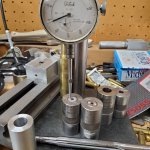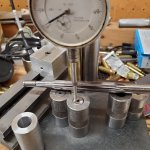Hello everyone,
I wanted to get some feedback on the SAC haedspace comparators. I been reloading for about 1yr and still learning.. Love the hobby but man some days just can't make things work.
I been using the Hornady headspace kit and it's worked for me. it take some time learning how to use them since there is a lot of play on the brass. For Christmas got some money so I went out and bought SAC comparator. For now I wanted to start out with the 223 and 308 WIN brass.
I received the kit a couple days ago and to my surprise I'm more confuse now on my measurements. I was wondering if someone might be able to help me understand something or I'm missing something.
I have fired brass from my Remington 700... Remington core-lokt ammo. All brass I have removed the primer and no brass has been resize yet.
Hornady Measurement using the D400 - 1.6230 to 1.6235
SAC headspace bushing 30 cal x 20 - 1.5335
a difference of 0.0895.
What gives dont understand why it's so off. I thought it would sorta match with the Hornady measurement. When I purchase the SAC kit I reach out to support to make sure I had the right kit.
Any feedback would be awesome... thank you,
I wanted to get some feedback on the SAC haedspace comparators. I been reloading for about 1yr and still learning.. Love the hobby but man some days just can't make things work.
I been using the Hornady headspace kit and it's worked for me. it take some time learning how to use them since there is a lot of play on the brass. For Christmas got some money so I went out and bought SAC comparator. For now I wanted to start out with the 223 and 308 WIN brass.
I received the kit a couple days ago and to my surprise I'm more confuse now on my measurements. I was wondering if someone might be able to help me understand something or I'm missing something.
I have fired brass from my Remington 700... Remington core-lokt ammo. All brass I have removed the primer and no brass has been resize yet.
Hornady Measurement using the D400 - 1.6230 to 1.6235
SAC headspace bushing 30 cal x 20 - 1.5335
a difference of 0.0895.
What gives dont understand why it's so off. I thought it would sorta match with the Hornady measurement. When I purchase the SAC kit I reach out to support to make sure I had the right kit.
Any feedback would be awesome... thank you,


